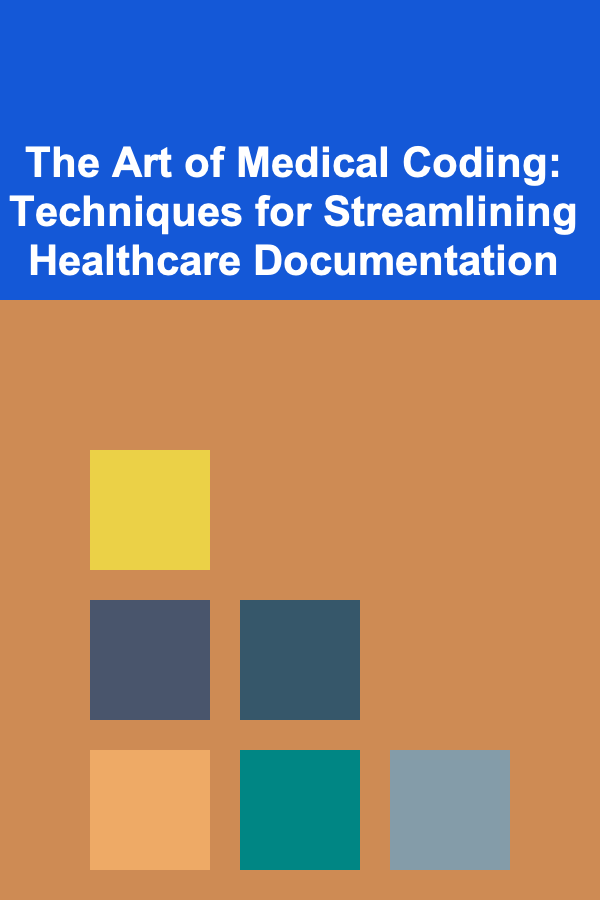
The Art of Medical Coding: Techniques for Streamlining Healthcare Documentation
ebook include PDF & Audio bundle (Micro Guide)
$12.99$9.99
Limited Time Offer! Order within the next:

Medical coding is a cornerstone of modern healthcare, transforming intricate medical data into structured, standardized formats that ensure proper billing, insurance reimbursement, and accurate patient records. Behind every diagnosis, procedure, or service lies a code that defines the patient's medical journey. However, the process of assigning the correct code requires precision, knowledge, and efficiency. In this article, we explore actionable techniques for streamlining healthcare documentation and optimizing medical coding workflows.
Medical coding not only plays a crucial role in clinical practices but also influences the financial health of healthcare institutions. The accuracy and efficiency of coding processes can directly impact claim approvals, reimbursement cycles, and regulatory compliance. Thus, understanding the art of medical coding and using the right strategies to streamline documentation is essential.
The Importance of Detailed and Accurate Documentation
Accurate medical coding begins with complete and detailed documentation. Without comprehensive notes from healthcare providers, coders face an uphill battle in selecting the correct codes. Vague or insufficient documentation leads to ambiguity, which in turn results in coding errors and, potentially, financial loss for healthcare providers.
Actionable Techniques:
- Comprehensive History and Examination: Medical practitioners should ensure that patient history, examinations, and diagnoses are fully documented. This includes not only the symptoms and diagnoses but also relevant medical history, lab results, and treatment plans.
- Use of Standardized Terminology: Encourage the use of well-defined and standardized terminology in documentation. This reduces ambiguity and simplifies the coder's job in identifying the correct codes. Terms such as "hypertension" should be used rather than general descriptions like "high blood pressure."
- Clarity in Procedures: Every procedure performed should be detailed in terms of both the type of procedure and the specific body part involved. If a procedure involves multiple steps or specific technologies, these should be specified clearly in the documentation.
- Clear Diagnosis and Treatment Correlation: Diagnoses should align with treatments and services provided. If the diagnosis changes or a secondary condition arises, the documentation should reflect this so coders can apply the most accurate codes.
Adopting a Structured and Consistent Approach to Coding
A methodical approach to coding ensures that every aspect of the medical record is reviewed, and no details are missed. Coders should work systematically, reviewing the patient's record step by step to avoid mistakes.
Actionable Techniques:
- Coding Hierarchy: When coding, start with the broadest diagnosis and proceed to the specific codes. For instance, if coding for cardiovascular conditions, begin with the general category for heart diseases and then refine to identify the specific condition (e.g., ischemic heart disease or heart failure). This ensures no important details are overlooked.
- Breakdown of Complex Cases: When handling complex cases, break down the coding process into manageable parts. Identify each diagnosis and treatment in segments before integrating them into the final set of codes. This minimizes the risk of misclassification.
- Double-Check for Multiple Conditions: For patients with multiple diagnoses, ensure that all relevant conditions are accounted for. Code for each condition that affects the treatment plan. However, ensure that each diagnosis code matches the treatment or procedure provided.
- Modular Approach to Procedures: For multi-step procedures or surgeries, break the process down into individual steps. This can prevent the omission of minor but significant details, such as anesthesia or post-operative care.
Leveraging Technology to Enhance Efficiency
In today's digital era, medical coding can benefit greatly from technological advancements. Coding software, Electronic Health Records (EHR), and artificial intelligence (AI)-powered tools can streamline many aspects of coding and reduce human error. However, while technology accelerates the process, it still requires careful monitoring to ensure accurate coding.
Actionable Techniques:
- Use EHR Systems with Integrated Coding Features: Modern EHR systems often come with coding suggestions based on the clinical documentation inputted. These suggestions can help speed up the coding process by proposing likely codes for a given diagnosis or procedure. While these suggestions are helpful, coders should always verify their accuracy before finalizing the codes.
- Implement Automated Coding Software: Some advanced coding software can help reduce manual input by suggesting codes based on predefined algorithms. These tools may also flag potential errors, such as incomplete documentation or inconsistent coding practices. It's crucial to integrate automated systems that can verify the codes based on the latest coding standards, such as ICD-10 and CPT codes.
- Invest in AI-Powered Coding Assistance: AI is revolutionizing medical coding by automating the process of identifying relevant codes and improving accuracy. AI algorithms can review large datasets, cross-reference patient records, and instantly provide the correct codes. Training coders to understand AI tools and using them to complement their work can significantly reduce error rates and improve productivity.
- Utilize Coding Auditing Tools: These tools are invaluable for ensuring compliance and accuracy. Automated audits can analyze the accuracy of codes, identify patterns of incorrect coding, and offer suggestions for improvement. This prevents costly mistakes and ensures that coding practices align with both medical standards and payer-specific guidelines.
Continuous Education and Certification for Coders
The field of medical coding is ever-evolving. With regular updates to coding standards, procedures, and regulatory guidelines, coders must continuously learn and adapt. Staying current with these changes not only ensures compliance but also improves the accuracy and speed of coding.
Actionable Techniques:
- Ongoing Training on New Codes and Updates: Coders should participate in regular training sessions, workshops, or webinars to stay updated on the latest coding standards, including updates to ICD-10, CPT, and HCPCS codes. Many coding institutions and professional organizations offer resources for continuous learning.
- Pursue Advanced Certifications: In addition to initial certification (such as those offered by the AAPC or AHIMA), coders should aim for advanced certifications in specific areas, such as coding for specific specialties (e.g., cardiology or neurology). Specialization improves knowledge and coding efficiency, enabling coders to work in niche areas where accuracy is particularly important.
- Engage in Peer Review and Auditing: Regularly participating in peer reviews and audits allows coders to identify areas for improvement and ensure they are following best practices. Collaborative learning is one of the most effective ways to sharpen coding skills.
- Utilize Professional Development Resources: Professional organizations such as the AAPC and AHIMA provide access to extensive resources, including coding updates, case studies, and peer discussion forums. Coders should take advantage of these resources to further their professional development.
Fostering Collaboration Between Coders and Healthcare Providers
For medical coding to be efficient and accurate, there needs to be an ongoing dialogue between coders and healthcare providers. Providers may have specialized knowledge that can help clarify documentation, while coders can offer feedback on documentation gaps that may hinder the coding process.
Actionable Techniques:
- Regular Communication with Healthcare Providers: Coders should communicate directly with physicians and other healthcare providers when documentation lacks clarity or is insufficient. If a diagnosis or procedure isn't clearly defined in the documentation, coders should ask for further clarification to ensure the correct code is assigned.
- Establish Coding Best Practices with Providers: Medical coders and healthcare providers should collaborate to develop standardized processes for documentation. This includes using consistent terminology, including all relevant details in medical records, and following templates that are conducive to accurate coding.
- Educate Providers on Documentation Requirements: Often, physicians may not be aware of how their documentation affects the coding process. Coders can provide educational sessions or materials to help healthcare providers understand the importance of clear and complete documentation.
- Feedback Loop for Continuous Improvement: Establish a feedback loop where coders report frequent errors or ambiguities in documentation back to the healthcare providers. This collaborative approach leads to better overall documentation and fewer coding mistakes.
Regular Audits and Quality Assurance
Medical coding requires consistent monitoring to ensure that errors are minimized and best practices are followed. Routine audits and quality assurance checks are essential for identifying potential issues before they result in claim denials or legal complications.
Actionable Techniques:
- Conduct Internal Audits: Regular internal audits allow coders to spot inconsistencies, outdated codes, or missing information. These audits help maintain accuracy across all medical coding processes and ensure compliance with regulatory guidelines.
- External Audits: Engaging third-party auditors can provide an impartial evaluation of your coding processes. Third-party audits are beneficial in identifying potential blind spots and offering recommendations for improvement.
- Use Audit Trails: Many coding systems and EHRs provide audit trails that document every change made to a patient's coding information. Reviewing these trails helps catch mistakes, track adjustments, and maintain accurate records of the coding process.
- Corrective Actions and Continuous Improvement: When errors or inefficiencies are discovered, it's crucial to implement corrective actions and monitor their effectiveness. This feedback loop ensures the ongoing refinement of coding practices.
Conclusion
The art of medical coding is far more than simply assigning numbers to diagnoses and procedures. It requires a nuanced understanding of clinical terminology, an attention to detail, and the ability to navigate complex coding systems. By adopting structured methodologies, leveraging technology, continuously educating oneself, fostering collaboration with healthcare providers, and regularly auditing practices, medical coders can streamline healthcare documentation and improve both efficiency and accuracy.
In the fast-paced world of healthcare, accurate and efficient coding can make the difference between timely reimbursement and delayed payments, between smooth operations and costly mistakes. The techniques outlined above provide actionable insights for coders looking to enhance their workflows, reduce errors, and optimize healthcare documentation processes. By honing the craft of medical coding, coders contribute to a healthcare system that is not only financially stable but also capable of delivering high-quality patient care.

How to Create a Cozy Atmosphere in Shared Spaces
Read More
How to Dust Your Home for Maximum Effectiveness
Read More
How to Organize Healthy Snacks for Quick Access
Read More
How to Reduce Your Monthly Expenses Effectively
Read More
How to Use Event Staffing to Make Money
Read More
How to Use Feedback from Past Yard Sales to Improve Future Sales
Read MoreOther Products

How to Create a Cozy Atmosphere in Shared Spaces
Read More
How to Dust Your Home for Maximum Effectiveness
Read More
How to Organize Healthy Snacks for Quick Access
Read More
How to Reduce Your Monthly Expenses Effectively
Read More
How to Use Event Staffing to Make Money
Read More